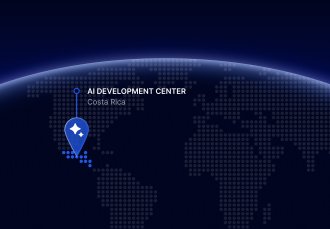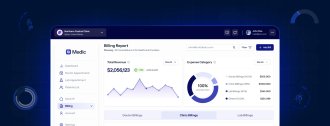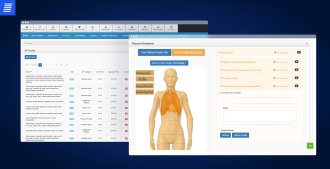
Contact us
Our team would love to hear from you.

The importance of data visualization in the healthcare sector is driven by digitalization trends, increasing data volumes, and the pursuit of improved performance.
Data visualization in healthcare isn’t a one-and-done solution–it’s a living, breathing process that must evolve with our understanding of patient needs and clinical workflows. Through continuous evaluation and refinement, we can make the most out of raw data—actionable insights that change healthcare for the better.
Delivery Manager
Data visualization presents complex information in formats that are easy-to-digest for various audiences, creating an array of advantages for healthcare organizations.
Visualizations make complex data crystal clear, so healthcare professionals can make smart decisions quickly. Beyond simply clarifying complex information, visualizations reveal outliers that might be missed in traditional tabular data display. It’s widely acknowledged that presenting data visually reduces the cognitive load required to process information, leading to faster comprehension and quicker decisions. This is particularly valuable in time-sensitive healthcare situations.
Visuals are a universal language in healthcare, helping diverse teams grasp medical data and collaborate successfully. Effective communication is crucial in healthcare, as breakdowns in communication are a leading cause of medical errors. Visualizations can bridge communication gaps between specialists, nurses, and patients, creating a foundation for a shared understanding of diagnosis and treatment plans.
Visual dashboards provide significant insight into how your hospital is running, facilitating data-driven decisions to improve efficiency and maximize resources. Using visuals to monitor key performance indicators (KPIs) like patient flow, bed occupancy rates, staff utilization, and resource allocation improves resource management and reduces costs. Real-time visibility into equipment usage can help identify bottlenecks and improve scheduling while monitoring supply levels can prevent stock-outs and reduce waste.
Data visualization can translate complex medical jargon into clear, accessible formats, empowering patients to understand their health and actively participate in their care. Engaged patients are more likely to adhere to treatment plans and experience better health outcomes. Data visualization also supports informed consent by presenting treatment options and potential risks and benefits in a clear, visual manner, fostering stronger patient–physician relationships.
Healthcare data visualization has many forms and facilitates various healthcare aspects and processes. Here’s an overview of its applications:
The market offers a wide range of data visualization tools. Below is a comparison of the most prominent ones:
| Tableau | Domo | Microsoft Power BI | Qlik | Looker | |
|---|---|---|---|---|---|
| Price | Tableau Desktop, offering limited features, is available for free. Tableau Viewer is priced at $15 per user per month, Tableau Explorer is $42 per user per month, and Tableau Creator costs $75 per user per month. | Pricing is arranged individually with the platform. Domo operates on a credit-based model; instead of paying for each feature individually, users purchase credits, which are depleted based on the amount of data handled and the frequency of data refreshes. | Power BI Desktop, with limited functionality, is free. Power BI Pro is available for $10 per user per month, while Power BI Premium costs $20 per user per month. | Qlik pricing starts at $825 per month for 20 users under its Standard plan. The Premium plan is priced at $2,500 per month for 20 users, while pricing for the Enterprise plan is discussed individually. | Looker offers Standard, Enterprise, and Embed plans, with pricing discussed individually. |
| Ease of learning | Offers a drag-and-drop interface with calculations similar to other software like Microsoft Excel or SQL, making it easy to learn. | The drag-and-drop interface allows users to create visualizations, dashboards, and reports without writing code. Pre-built connectors to common data sources simplifies the data import process. | Its similarity to Microsoft Excel makes it relatively easy to learn. However, users may require some training to navigate its more challenging features, like DAX. | Can be more challenging than other tools due to its data modeling complexity and its proprietary scripting language for data transformations and ETL. | Provides a user-friendly interface and intuitive dashboarding; however, it requires SQL/LookML knowledge for setup and customization, which can be challenging for nontechnical specialists. |
| Unique features | Unique VizQL engine enables an intuitive analytics experience. | Social elements like sharing, comments, and mentions enhance teamwork. | Offers intelligent narratives and anomaly detection features. As part of the Microsoft Cloud for Healthcare platform, it is tailored to the healthcare industry by default. | Allows multi cloud and on-premises installations without restricting users to any specific cloud. | The modeling language, LookML, enables data teams to define and centralize data logic, metrics, and calculations, ensuring consistent analytics without requiring individual users to write SQL. |
| Limitations | Not suited for large datasets. | Limited customization capabilities. | Azure-only deployment. | Limited visualization capabilities compared to other BI tools. | Can be expensive, making it inaccessible to smaller organizations. |
The complexity of medical data and the related nuances can pose certain challenges that must be addressed to ensure successful data visualization initiatives.
The healthcare industry generates vast amounts of data from diverse sources, often stored in disparate systems and formats. This fragmentation creates so called ‘data silos’ that hinder effective data integration and analysis. There is no question that effective data integration pipelines are crucial for consolidating information from various sources (electronic health records, lab systems, imaging devices, wearables, etc.) and maintaining data integrity and accuracy. For these purposes, conformance to interoperability standards, such as FHIR (Fast Healthcare Interoperability Resources), is essential.
Healthcare data is highly sensitive and subject to strict privacy regulations, such as HIPAA in the United States, GDPR in Europe. Visualizations must be designed with privacy in mind, incorporating de-identification techniques, access controls, and security measures to protect patient confidentiality. Balancing the need for actionable insights with the need to safeguard patient privacy requires careful planning and adherence to regulatory requirements. Techniques like differential privacy can help provide aggregate insights while preserving individual privacy.
Creating data visualization tools that are both informative and easy to understand can be a challenging task. Overly complex graphics and terminology can lead to misinterpretation, while simplistic presentations may fail to capture the intricacies of the data. The optimal approach depends on the specific audience and the goals of the visualization. For clinicians, detailed visualizations might be appropriate, while for patients, simpler and more intuitive displays are often preferred. User-centered design principles, including usability testing and iterative design, are essential for creating effective visualizations that meet the needs of diverse stakeholders.
We begin by engaging with stakeholders to thoroughly understand their data visualization goals, target audience, available data sources, and technical constraints. This involves conducting interviews, reviewing existing documentation, and analyzing sample data to understand the project context.
We work with clients to design and develop interactive prototypes of the visualization solution. This iterative process allows us to gather feedback early and often to ensure the final product meets the needs of all stakeholders. We adhere to user-centered design principles focused on usability, accessibility, and adherence to healthcare-specific design guidelines.
We develop data pipelines to integrate data from diverse sources and guarantee data quality, consistency, and accuracy. We use industry-standard interoperability standards, such as FHIR, and employ data cleaning and transformation techniques to prepare the data for visualization.
We carefully select the most appropriate technologies, frameworks, and tools for each project to maximize security and performance. Our development process follows Agile methodologies, with continuous testing and integration to ensure high quality and rapid iteration.
We deploy the visualization solution and provide training and documentation to help users effectively integrate the tools into their workflows. We offer ongoing support and maintenance to ensure the long-term success of the project.
We believe data visualization is an ongoing process. We work with clients to evaluate the effectiveness of the solution and identify areas for further improvement or advancement. Supported by data, we refine visualizations to ensure they continue to meet the evolving needs of the healthcare organization.
For many years, we’ve been collaborating with healthcare companies, creating powerful data visualization solutions.


Healthcare data visualization is changing the way we understand and use medical information, from clinical decision making to patient care planning. While the opportunities for integration are great, success requires overcoming complex challenges such as data fragmentation and privacy requirements. With the right expertise, these hurdles become stepping stones to impactful insights that drive better healthcare outcomes. Are you ready to unlock the potential of your healthcare data? Let’s connect and explore how we can help you achieve your visualization goals.

Data visualization in healthcare is the graphical representation of complex medical data in charts, graphs, tables, dashboards, and other formats that allow users to quickly obtain meaningful insights and make decisions.
The cost of health data visualization varies depending on the specifics of the project and the tools used for data analysis and visualization. Since data visualization encompasses a range of solutions, you have numerous options when determining which tool best meets your requirements. Contact us for an estimate on your healthcare data visualization project.
Medical data visualization enables healthcare professionals to quickly evaluate vast amounts of data, allowing them to prescribe necessary therapies and care in the shortest possible time. This efficiency expedites recovery while minimizing the risk of complication.
Yes! Data visualization tools can integrate with EHR systems, significantly enhancing how healthcare providers interpret and use patient data. Data visualization facilitates data centralization, supports clinical decision-making, enables patient outcome forecasting, improves patient engagement, and more.
We envision the future of healthcare data visualization as closely linked to the latest technologies.
Artificial intelligence (AI) and ML techniques enable automated insights and predictions, allowing doctors to uncover hidden patterns in vast datasets, resulting in more accurate diagnoses and treatment plans.
Virtual and augmented reality (VR and AR) facilitate immersive and interactive experiences in data analysis. Healthcare professionals can use VR to better understand and make decisions about complex anatomical systems, medical procedures, and treatment outcomes.
Real-time data streaming allows healthcare practitioners to view and analyze data as it is created, resulting in proactive and timely treatments.
Can’t find the answer you are looking for?
Contact us and we will get in touch with you shortly.
Our team would love to hear from you.
Fill out the form, and we’ve got you covered.
What happens next?
San Diego, California
4445 Eastgate Mall, Suite 200
92121, 1-800-288-9659
San Francisco, California
50 California St #1500
94111, 1-800-288-9659
Pittsburgh, Pennsylvania
One Oxford Centre, 500 Grant St Suite 2900
15219, 1-800-288-9659
Durham, North Carolina
RTP Meridian, 2530 Meridian Pkwy Suite 300
27713, 1-800-288-9659
San Jose, Costa Rica
C. 118B, Trejos Montealegre
10203, 1-800-288-9659